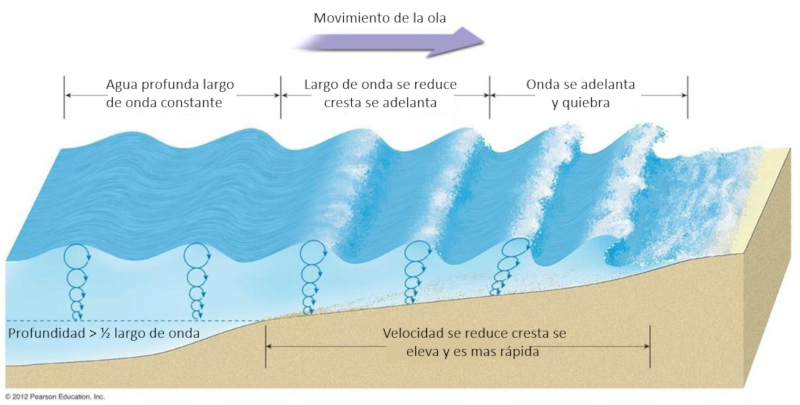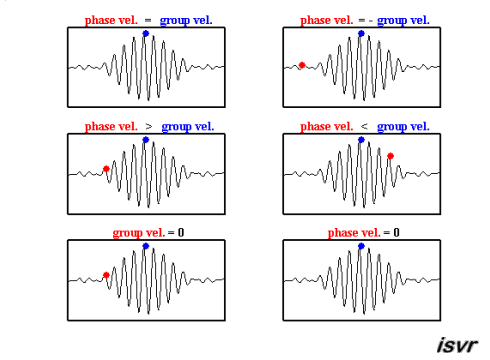Breaking waves
Storyboard 
The air currents over the ocean drive the movement of the water, generating waves that behave differently under fluctuations depending on the depth. This phenomenon is known as wave breaking. Wave breaking occurs because the propagation speed of a wave is greater in areas of deeper water. Thus, as waves approach the shore, those from deeper areas tend to overtake those from shallower areas, resulting in the characteristic breaking of the wave.
ID:(1632, 0)
Break of the wave on the beach
Image 
When a wave reaches the shore, it starts to climb up the beach slope, becoming progressively shallower and slower. A following wave tends to rise over the preceding wave. As the water becomes deeper in this situation, it becomes faster and tends to overtake the previously arrived water. This interaction ultimately leads to the wave breaking, creating the phenomenon known as surf.

ID:(12308, 0)
Angular frequency
Note 
Recalling that angular velocity represents the angle traversed per unit of time, it can be observed that the expression
$\displaystyle\frac{2\pi}{T}$
corresponds to a complete revolution ($2\pi$) divided by the time the period ($T$), which is required for one cycle. Therefore, the angular frequency ($\omega$) is defined as
| $ \omega = \displaystyle\frac{2 \pi }{ T }$ |
ID:(15648, 0)
Wave vector
Quote 
The wave vector ($k$) is the factor that multiplies the position and corresponds to the value for which, if the wave moves along a wave length ($\lambda$), it assumes the same shape it initially had. For this to occur, the following condition must be met:
$kx = k\lambda = 2\pi$
Therefore, with the wave length ($\lambda$), we establish that:
| $ k =\displaystyle\frac{2 \pi }{ \lambda }$ |
ID:(15647, 0)
Wave phase velocity
Exercise 
The speed of waves depends on the water depth and the factor the wave vector ($k$), which is calculated using the wave length ($\lambda$) as follows:
| $ k =\displaystyle\frac{2 \pi }{ \lambda }$ |
Regarding the phase speed ($c_p$), which corresponds to the speed at which each wave crest moves, this can be determined using the ocean depth ($h$) and the gravitational Acceleration ($g$). The phase speed ($c_p$) is calculated as:
| $ c_p =\sqrt{\displaystyle\frac{ g }{ k } \tanh( k h )}$ |
The phase velocity refers to the speed at which a specific oscillation or wave moves.
ID:(15649, 0)
Wave group velocity
Equation 
Waves have a speed that depends on the water depth and the factor the wave vector ($k$), calculated using the wave length ($\lambda$) as follows:
| $ k =\displaystyle\frac{2 \pi }{ \lambda }$ |
For the group speed ($c_g$), which represents the speed at which the entire wave train moves, not each individual wave, it can be calculated using the phase speed ($c_p$). This is determined with the ocean depth ($h$) and the gravitational Acceleration ($g$), in the following way:
| $ c_p =\sqrt{\displaystyle\frac{ g }{ k } \tanh( k h )}$ |
Finally, using this information, the group speed ($c_g$) can be calculated through the following expression:
| $ c_g =\displaystyle\frac{ c_p }{2}\left(1 + \displaystyle\frac{2 k h }{\sinh(2 k h )}\right)$ |
The group velocity is the speed at which the train or group of waves moves through the water medium.
ID:(15650, 0)
Wave speeds
Script 
There are two characteristic speeds in wave mechanics. On one hand, there is the speed at which a specific wave travels, which can vary based on frequency, thus differing from one wave to another.
The second type of speed observed is that of a wave packet, that is, a group of waves of different frequencies and phases which, when superimposed, form a group that moves as a unit. This speed is known as the group velocity.
Both can be observed in this animation:

ID:(15651, 0)
Wave description
Variable 
A wave can be approximately described as a sinusoidal function depending on the variables the position ($x$) and the time ($t$).
The function incorporates the values of the wave height ($u$) at each point, as well as the maximum wave height ($z_0$), the wave vector ($k$), and the frecuencia angular ($\omega$):
| $ u( x , t ) = z_0 \cos( k x - \omega t )$ |
ID:(15646, 0)
Breaking waves
Storyboard 
The air currents over the ocean drive the movement of the water, generating waves that behave differently under fluctuations depending on the depth. This phenomenon is known as wave breaking. Wave breaking occurs because the propagation speed of a wave is greater in areas of deeper water. Thus, as waves approach the shore, those from deeper areas tend to overtake those from shallower areas, resulting in the characteristic breaking of the wave.
Variables
Calculations
Calculations
Equations
Examples
When a wave reaches the shore, it begins to rise as it moves up the beach slope, becoming increasingly shallow and therefore slower. A second wave following it tends to rise over the previous one. Since the water is deeper in this region, the second wave moves faster and tends to overtake the first wave that reached the shore. This interaction between waves causes wave breaking, creating the phenomenon known as the surf zone.
This phenomenon can be modeled using the description of the wave height ($u$) by means of a the maximum wave height ($z_0$) wave that propagates with a the wave vector ($k$) and the frecuencia angular ($\omega$), whose expression in the position ($x$) and the time ($t$) is:
The water itself follows a circular motion, with a velocity that satisfies the relationships with the wave speed ($v_{\omega}$) and the ocean depth ($h$):
and
Recalling that angular velocity represents the angle traversed per unit of time, it can be observed that the expression
$\displaystyle\frac{2\pi}{T}$
corresponds to a complete revolution ($2\pi$) divided by the time the period ($T$), which is required for one cycle. Therefore, the angular frequency ($\omega$) is defined as
The wave vector ($k$) is the factor that multiplies the position and corresponds to the value for which, if the wave moves along a wave length ($\lambda$), it assumes the same shape it initially had. For this to occur, the following condition must be met:
$kx = k\lambda = 2\pi$
Therefore, with the wave length ($\lambda$), we establish that:
Wave speed depends on water depth and the factor the angular frequency ($\omega$), which is determined from the phase speed ($c_p$) and the wave vector ($k$) as follows:
Regarding the phase speed ($c_p$), which represents the speed at which each wave crest propagates, it can be calculated using the ocean depth ($h$) and the gravitational Acceleration ($g$). The value of the phase speed ($c_p$) is obtained as:
In this context, phase velocity refers to the speed at which an individual oscillation or wave propagates.
Waves have a speed that depends on the water depth and the factor the wave vector ($k$), calculated using the wave length ($\lambda$) as follows:
For the group speed ($c_g$), which represents the speed at which the entire wave train moves, not each individual wave, it can be calculated using the phase speed ($c_p$). This is determined with the ocean depth ($h$) and the gravitational Acceleration ($g$), in the following way:
Finally, using this information, the group speed ($c_g$) can be calculated through the following expression:
The group velocity is the speed at which the train or group of waves moves through the water medium.
There are two characteristic speeds in wave mechanics. On one hand, there is the speed at which a specific wave travels, which can vary based on frequency, thus differing from one wave to another.
The second type of speed observed is that of a wave packet, that is, a group of waves of different frequencies and phases which, when superimposed, form a group that moves as a unit. This speed is known as the group velocity.
Both can be observed in this animation:
The wave vector ($k$) is with the wave length ($\lambda$) equal to:
The angular frequency ($\omega$) is with the period ($T$) equal to
The dispersion relation links the angular frequency ($\omega$) with the wave vector ($k$), and it can be expressed using the phase speed ($c_p$), since this corresponds to the ratio of the first to the second. Therefore, the relation can be written as:
The phase speed ($c_p$) corresponds to the speed at which each wave crest moves, which can be determined using the values the ocean depth ($h$), the wave length ($\lambda$), and the gravitational Acceleration ($g$). The speed the phase speed ($c_p$) is calculated as follows:
The group speed ($c_g$) is calculated using the values of the wave vector ($k$), the ocean depth ($h$), and the gravitational Acceleration ($g$) as follows:
A wave can be approximately described as a sinusoidal function depending on the variables the position ($x$) and the time ($t$).
The function incorporates the values of the wave height ($u$) at each point, as well as the maximum wave height ($z_0$), the wave vector ($k$), and the frecuencia angular ($\omega$):
The wave is composed of zones that circulate with a the angular frequency ($\omega$) and the wave speed ($v_{\omega}$), calculated from the maximum wave height ($z_0$), the wave vector ($k$), and the ocean depth ($h$) using:
The horizontal movement of water in the wave occurs with the horizontal speed of the wave ($v_{\omega,x}$), which depends on the wave speed ($v_{\omega}$), the ocean depth ($h$), the wave vector ($k$), and the angular frequency ($\omega$), for the position ($x$), the wave height ($u$), and the time ($t$), using:
The vertical movement of water in the wave occurs with the vertical speed of the wave ($v_{\omega,z}$), which depends on the wave speed ($v_{\omega}$), the ocean depth ($h$), the wave vector ($k$), and the angular frequency ($\omega$), for the position ($x$), the wave height ($u$), and the time ($t$), using:
ID:(1632, 0)
